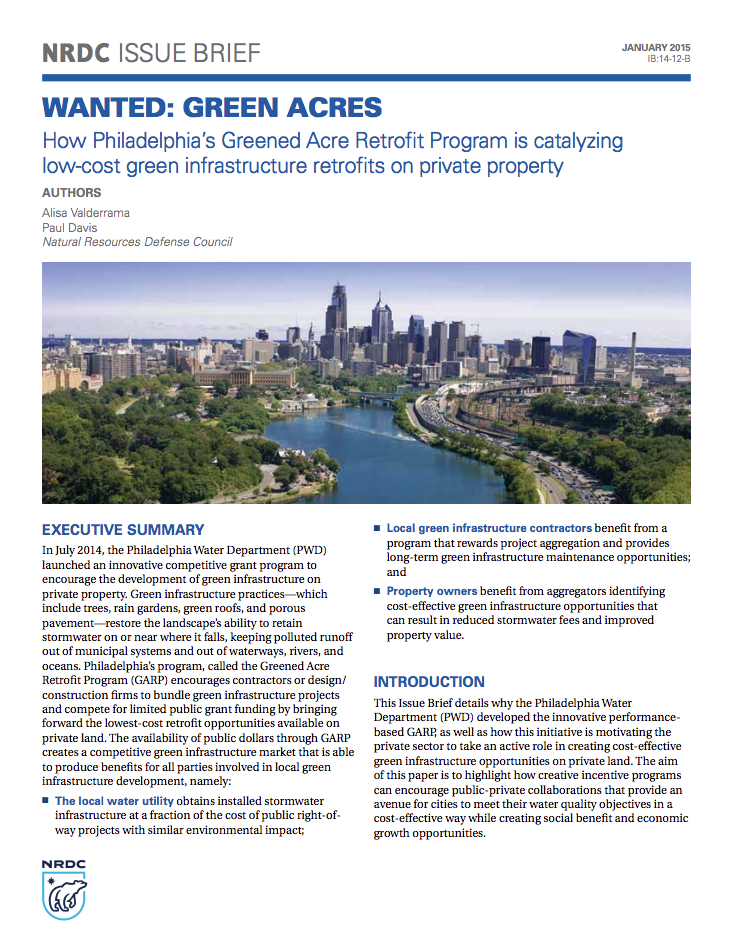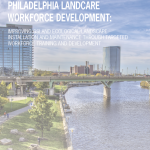Wanted: Green Acres
The Urban Stormwater Problem
Managing stormwater runoff is an issue of rising concern for U.S. municipalities. Urban and suburban development transforms natural landscapes into impervious surfaces such as streets, rooftops, and parking lots. These hard surfaces prevent rainwater from soaking into underlying soils. During rainstorms, impervious surfaces produce stormwater runoff surges that mobilize a wide range of pollutants including fertilizers, pesticides, oils, metals, trash, and bacteria. An estimated 10 trillion gallons per year of this polluted mix flows uninhibited and untreated into local waterways.
Two systems are currently used in cities to convey stormwater, both which fail to protect water quality under ordinary conditions. "Separate" stormwater sewer systems collect only stormwater and transmit it with little or no treatment to a receiving body of water, where stormwater and accumulated pollutants are released. In more than 700 U.S. cities with older stormwater infrastructure -- like Philadelphia -- stormwater and wastewater flow into a single piping system, known as a "combined" sewer system. During a rainstorm, combined sewer systems mix stormwater runoff with wastewater from sinks, toilets, and showers. The resulting volume overwhelms the combined sewer system, leading to overflows of raw sewage, polluting waterways, and presenting a public health threat. Whether a city uses a primarily separate or combined sewer system, or uses some mix of both systems, finding a cost-effective way to manage stormwater runoff volume is a critical issue for any city seeking to protect the quality and health of their communities' local waterways.
Rise of Municipal Green Infrastructure and Incentive Programs
To reduce the impacts of urban stormwater runoff and meet regulatory compliance obligations under the Clean Water Act, many cities have begun to invest in green infrastructure. These practices -- which include trees, rain gardens, green roofs, and porous pavement -- restore the landscape's ability to retain stormwater on or near where it falls, keeping rainwater out of municipal sewer systems and waterways. Through the development of green infrastructure assets in urban environments, cities across the country are finding that they can effectively manage stormwater runoff and improve local water quality in a way that is more cost-effective and generates more community benefits than traditional "pipe and cement" based approaches alone.
With a large proportion of paved urban land in the hands of private property owners, cities are realizing that private landowner involvement is critical to meeting their green infrastructure development and stormwater runoff reduction goals in a cost-effective manner. Strategic public policies are key to encouraging private property participation in reducing stormwater runoff. For example, many cities now require that new development or redevelopment projects above a specific square footage build the infrastructure to manage stormwater runoff on-site, as a condition of permit approval. While such development guidelines ensure better water management from future construction, urban waterways are substantially impacted by polluted runoff from existing development. As a result, stormwater utilities have attempted to accelerate installation of green infrastructure on existing commercial and residential properties by offering incentives such as construction cost subsidies and reduced stormwater fees to property owners who voluntarily retrofit existing properties with green infrastructure.
Philadelphia's Green Infrastructure Goals and Motivating Private Property Participation
In July 2014, the Philadelphia Water Department (PWD) launched an innovative competitive grant program to encourage the development of green infrastructure on private property. Green infrastructure practices -- which include trees, rain gardens, green roofs, and porous pavement -- restore the landscape's ability to retain stormwater on or near where it falls, keeping polluted runoff out of municipal systems and out of waterways, rivers, and oceans. Philadelphia's program, called the Greened Acre Retrofit Program (GARP) encourages contractors or design/construction firms to bundle green infrastructure projects and compete for limited public grant funding by bringing forward the lowest-cost retrofit opportunities available on private land. The availability of public dollars through GARP creates a competitive green infrastructure market that is able to produce benefits for all parties involved in local green infrastructure development, namely:
- The local sewer or stormwater utility obtains installed (and privately maintained) stormwater infrastructure at a fraction of the cost of public right-of-way projects with similar environmental benefit;
- Local green infrastructure contractors benefit from a program that rewards project aggregation and provides long-term green infrastructure maintenance opportunities; and
- Property owners benefit from aggregators identifying cost-effective green infrastructure opportunities that can result in reduced stormwater fees and improved property value.
Published: February 2015



